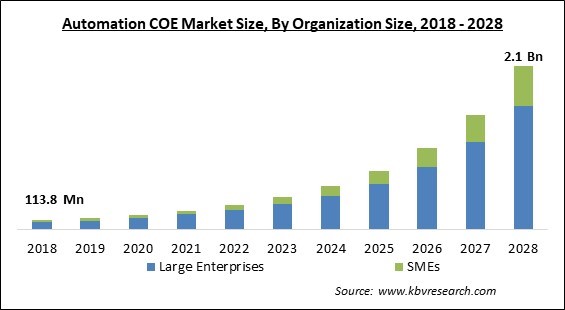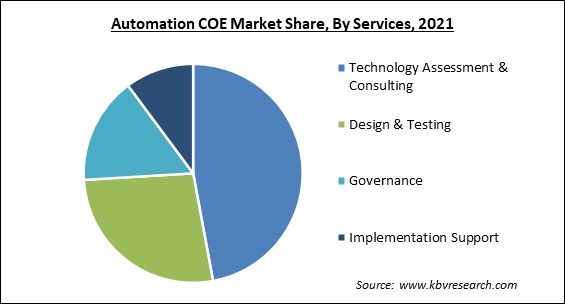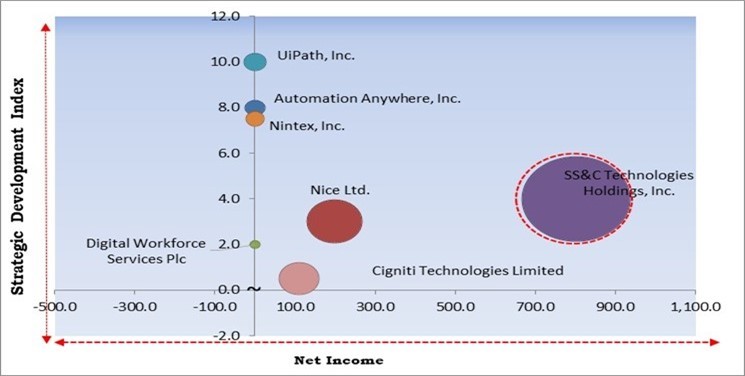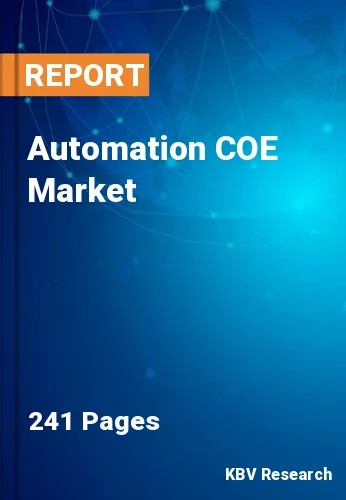The Global Automation COE Market size is expected to reach $2.1 billion by 2028, rising at a market growth of 37.2% CAGR during the forecast period.
A self-sustaining, internal, and scalable team of specialists known as an automation Centre of Excellence (CoE) manages and operates software robots. The implementation of robotic process automation (RPA) standards procedures and processes across the whole organization helps in sharing best practices, promoting the adoption of common technology, and developing a strong governance model.

To scale up their projects and optimize the advantages of automation, both businesses that are just starting to use robotics and organizations that have already begun to benefit from automation can construct an automation CoE. Rapid transformation is made possible by the center of excellence, which also manages associated risks, and makes sure that the automation expenditures are managed properly.
It thus, makes it possible to enable the business to run and track its initiatives effectively. Automation CoE lies at the nexus of speed, control, and agility. Process automation is no longer considered a novelty. The management of a company, as well as its clients, suppliers, partners, employees, and shareholders, all have a fundamental expectation that automation will increase productivity and human potential.
A company can have severe congestion if automation initiatives are scattered throughout the company. Implementing a center of excellence, a form of controller that's necessary for accelerating and scaling enterprise automation efforts, is a method to prevent backups and retain control.
The pandemic had a positive impact on the automation CoE market. To make it easier for employees to complete work from home, businesses throughout the globe were rushing to ensure that every worker has access to the necessary amount of internet bandwidth to perform their jobs effectively while staying put. Companies employed bots to look at the zip codes of employees, find out what the internet speed is in their area, and collect information about employees' Wi-Fi plans to configure where improvements need to be made to employee internet packages.
Without an automation business model, a decentralized approach to ROI can quickly get out of control owing to inadequate RPA acquisition, process automation selection, support, and training. This is especially important if there is no automation operating model in place. In addition, business units frequently select projects that are excellent prospects for automation in an attempt to get rapid returns on investment. Businesses typically steer clear of more complicated strategic initiatives that, among many other things, require cooperation from the IT department. Greater ROIs, however, are connected with bigger, more complex endeavors.
According to the findings of the research, studies of automation created opportunities for both employment creation and autonomy. Employees reported that automation assisted them in reducing the amount of repetitive work they had to do, giving them more time to engage in external and internal collaborative efforts and cooperation. This additionally helped in redeveloping facilities, and/or overcoming more complex employment problems that can contribute to value-adding innovation and solutions. A study found that employees asserted that automation contributed to reducing the amount of repetitive work they had to do.
The deployment costs of RPA account for a sizeable portion of the total ownership cost of an RPA program and can be responsible for almost half of the initial costs incurred. Documents known as SDDs (solution design documents), or PDDs (process design documents) which are normally prepared on paper and used to instruct developers about automation design, are now considered archaic. If there is not a proper governance system in place, these attempts at automation are likely to fail right from the beginning.
On the basis of organization size, the automation COE market is divided into large enterprises and SMEs. The large enterprise segment procured the largest revenue share in the automation CoE market in 2021. Large enterprises typically have extensive corporate networks as well as a variety of different income streams. They frequently make investments in cutting-edge technology in order to improve their operational efficiencies. Large companies have dominance in the automation COE market because the sophistication of their partner networks gives them a competitive advantage.

Based on services, the automation COE market is categorized into technology assessment & consulting, design & testing, governance, and implementation support. The design and testing segment acquired a significant revenue share in the automation CoE market in 2021. Test Automation refers to the process of making use of software in order to test the effectiveness of the software in order to get an evaluation of real results. The application of test automation is best suited for large-scale projects as well as those that call for testing of the same tasks on multiple occasions.
Based on verticals, the automation COE market is segmented into BFSI, IT & ITES, retail & consumer goods, healthcare & life sciences, manufacturing, transportation & logistics, and others (education, government, telecom, and energy & utilities). The retail and consumer goods segment procured a significant revenue share in the automation of CoE market in 2021. As robots with their control systems are becoming more powerful and adaptable, robotics is transitioning from heavy industrial uses to the production of consumer goods. Consumers seek products in novel forms, which appeals to the natural adaptability of robotics while maintaining local production.
| Report Attribute | Details |
|---|---|
| Market size value in 2021 | USD 238.3 Million |
| Market size forecast in 2028 | USD 2.1 Billion |
| Base Year | 2021 |
| Historical Period | 2018 to 2020 |
| Forecast Period | 2022 to 2028 |
| Revenue Growth Rate | CAGR of 37.2% from 2022 to 2028 |
| Number of Pages | 241 |
| Number of Tables | 394 |
| Report coverage | Market Trends, Revenue Estimation and Forecast, Segmentation Analysis, Regional and Country Breakdown, Competitive Landscape, Companies Strategic Developments, Company Profiling |
| Segments covered | Service, Organization Size, Vertical, Region |
| Country scope | US, Canada, Mexico, Germany, UK, France, Russia, Spain, Italy, China, Japan, India, South Korea, Singapore, Malaysia, Brazil, Argentina, UAE, Saudi Arabia, South Africa, Nigeria |
| Growth Drivers |
|
| Restraints |
|
On the basis of region, the automation COE market is analyzed across North America, Europe, Asia Pacific and LAMEA. The North American segment garnered the highest revenue share in the automation CoE market in 2021. This is because this region has economies that have been around for a long time, and automation COE solution suppliers can afford to invest in cutting-edge technology. Additionally, this region is considered to be the epicenter of creativity as key players in IT are inspired to create and develop new products and services.
Free Valuable Insights: Global Automation COE Market size to reach USD 2.1 Billion by 2028

The major strategies followed by the market participants are Product Launches. Based on the Analysis presented in the Cardinal matrix; SS&C Technologies Holdings, Inc. is the major forerunner in the Automation COE Market. Companies such as Nice Ltd., UiPath, Inc. and Automation Anywhere, Inc. are some of the key innovators in Automation COE Market.
The market research report covers the analysis of key stake holders of the market. Key companies profiled in the report include SS&C Technologies Holdings, Inc., UiPath, Inc., Automation Anywhere, Inc., Nice Ltd., HelpSystems, LLC, Nintex, Inc., Verint Systems, Inc., Cigniti Technologies Limited, Digital Workforce Services Plc and Fastpath Solutions, LLC.
By Organization Size
By Services
By Vertical
By Geography
The global Automation COE Market size is expected to reach $2.1 billion by 2028.
Aids in increasing return on investments across business are driving the market in coming years, however, High costs of deployment and development of RPA restraints the growth of the market.
SS&C Technologies Holdings, Inc., UiPath, Inc., Automation Anywhere, Inc., Nice Ltd., HelpSystems, LLC, Nintex, Inc., Verint Systems, Inc., Cigniti Technologies Limited, Digital Workforce Services Plc and Fastpath Solutions, LLC.
The pandemic had a positive impact on the automation CoE market. To make it easier for employees to complete work from home, businesses throughout the globe were rushing to ensure that every worker has access to the necessary amount of internet bandwidth to perform their jobs effectively while staying put.
The Technology Assessment & Consulting market acquired the maximum revenue share in the Global Automation COE Market by Services in 2021; thereby, achieving a market value of $937.5 million by 2028.
The North America market dominated the Global Automation COE Market by Region in 2021; thereby, achieving a market value of $842.0 million by 2028.
Our team of dedicated experts can provide you with attractive expansion opportunities for your business.

